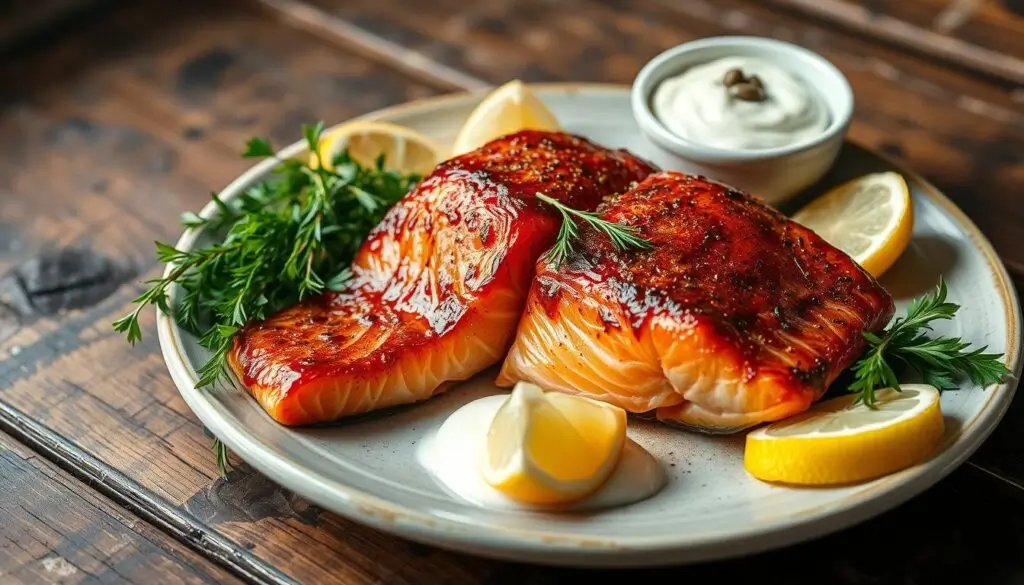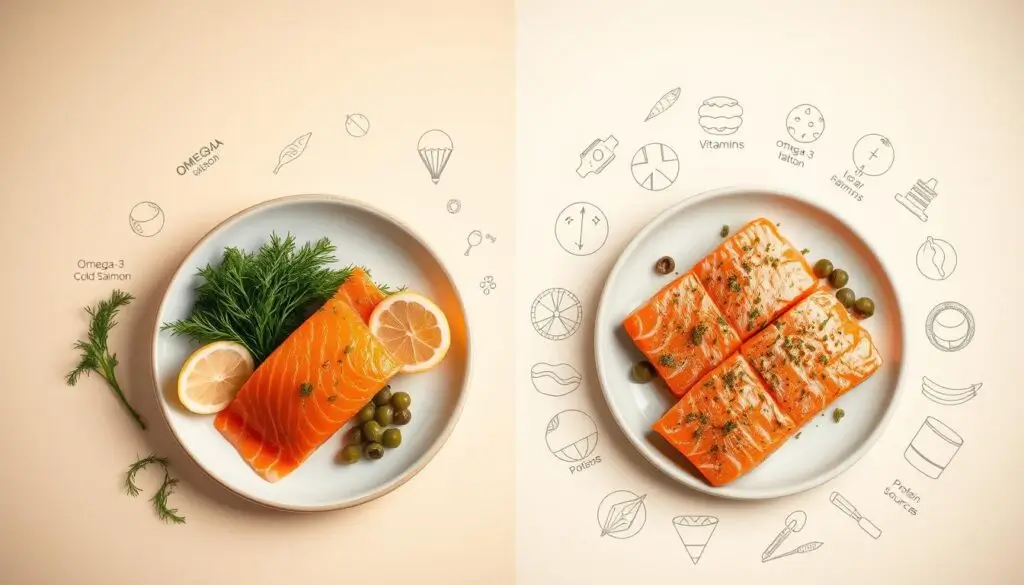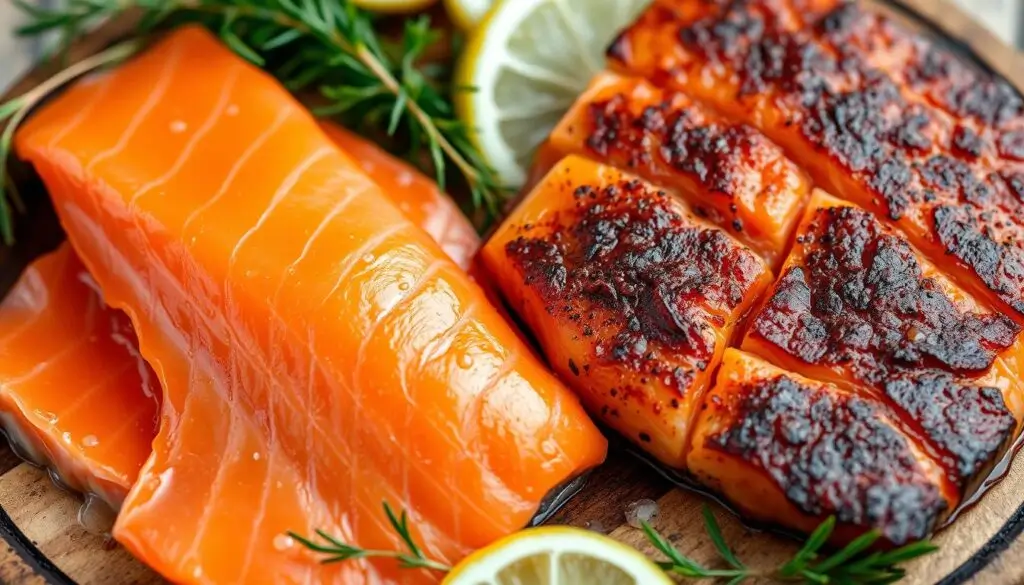Did you know the global smoked salmon market is expected to hit $34.5 billion by 2027? This huge demand shows just how much people love this tasty fish. But, not all smoked salmon is the same. Understanding the difference between smoked salmon vs hot smoked salmon is key for seafood lovers and cooks. Whether you’re looking for a delicate texture or a bolder, flaky option, knowing the distinctions can elevate your culinary experience.
Understanding the Basics of Salmon Smoking
Salmon smoking is a tradition that adds a smoky flavor to the fish. To know the difference between smoked and hot smoked salmon, we need to learn the basics. This includes traditional methods and the importance of temperature.
Traditional Smoking Methods
For centuries, people have smoked salmon using old techniques. These methods control the temperature and time to get the right flavor. Curing the salmon with salt, sugar, or spices also adds to its taste and texture.
The Role of Temperature in Smoking
Temperature is key in salmon smoking. It affects how the fish is cooked and the flavors it gets. Cold smoking uses low temperatures to add smoke without cooking the fish too much. Hot smoking, on the other hand, cooks and smokes the salmon at higher temperatures.
Essential Equipment for Smoking Salmon
- Smoker or smoking chamber: A special device for even smoking, with controlled heat and smoke.
- Wood chips or chunks: Different woods like alder, oak, or hickory give unique flavors.
- Meat thermometer: Important for checking the salmon’s internal temperature during smoking.
- Curing ingredients: Salt, sugar, and spices are used to prepare the salmon for smoking.
Learning the basics of salmon smoking helps you understand its flavors and textures. This includes traditional methods, temperature’s role, and the necessary equipment.
Cold Smoking vs Hot Smoking: The Core Differences
When making delicious smoked salmon, you’ll find two main methods: cold smoking and hot smoking. It’s important to know how these methods differ. This helps you understand the special qualities of cold smoked salmon and hot smoked salmon.
The main difference is in the temperature used. Cold smoking happens at 68°F to 86°F. On the other hand, hot smoking uses temperatures between 120°F and 200°F.
The temperature affects the salmon’s texture and taste. Cold smoked salmon is soft and silky. This is because the low temperatures add a light, smoky flavor. In contrast, hot smoked salmon is firmer and has a stronger smoky taste. This is because the higher temperatures make the salmon more dense and smoky.
| Characteristic | Cold Smoked Salmon | Hot Smoked Salmon |
|---|---|---|
| Temperature Range | 68°F to 86°F | 120°F to 200°F |
| Texture | Silky, velvety | Firm, pronounced |
| Flavor Intensity | Delicate, subtle smoke | Robust, pronounced smoke |
The time it takes to smoke the salmon also differs. Cold smoking can take days or weeks. This slow process lets the fish soak up the smoky flavors. Hot smoking, however, is much quicker, usually taking just a few hours.
The differences in temperature and time lead to unique textures and tastes. These differences cater to different tastes in salmon. Knowing the basics of cold smoked salmon and hot smoked salmon helps you choose what you like best.
The Art of Cold Smoking Salmon
Cold smoking salmon is a delicate art. It needs careful temperature control, the right smoking time, and the best wood. This method gives salmon a unique taste and texture, making it a favorite in cooking.
Temperature Control in Cold Smoking
Keeping the temperature steady is crucial in cold smoking. It should be between 70°F and 90°F. This low heat lets the smoke add a deep flavor without cooking the fish. It’s important to watch the temperature closely to keep it just right.
Duration and Timing Factors
Cold smoking salmon takes 12 to 24 hours. The exact time depends on the fish’s thickness, the wood type, and how smoky you like it. Skilled cold smokers track the time closely to get the perfect smoke.
Wood Selection for Cold Smoking
The wood used in cold smoking greatly affects the salmon’s flavor. Alder, oak, and apple wood are common choices. Alder gives a light, delicate smoke, while oak adds a strong, earthy taste. Trying different woods can help you find your favorite flavor.
Learning the art of cold smoking can take your salmon dishes to the next level. It opens up a world of flavors and aromas that will impress your taste buds and leave a lasting memory.
Hot Smoking Techniques and Process
If you love the smoky taste of hot smoked salmon, you’ll find the process fascinating. It’s different from cold smoking because it uses higher temperatures for a shorter time. This creates a unique texture and flavor.
Hot smoking happens at 120°F to 180°F, much warmer than cold smoking’s 70°F to 90°F. This heat cooks the salmon and changes its proteins and fats. This makes the salmon firm and flaky, unlike cold smoked salmon’s silkier texture.
Hot smoking is quicker, lasting just a few hours. Cold smoking can take days or weeks. This quick process keeps the salmon’s oils and gives it a bold, smoky flavor that many love.
| Characteristic | Hot Smoked Salmon | Cold Smoked Salmon |
|---|---|---|
| Temperature Range | 120°F to 180°F | 70°F to 90°F |
| Smoking Duration | 2-4 hours | Days or weeks |
| Texture | Firm, flaky | Silky, delicate |
| Flavor Intensity | Bold, intense smoky flavor | Subtler, more delicate smoke flavor |
Whether you like the gentle taste of cold smoked salmon or the strong taste of hot smoked salmon, knowing about these salmon preparation styles is key. It helps you choose and enjoy different flavors in your cooking.

Smoked Salmon vs Hot Smoked Salmon: A Detailed Comparison
Exploring the differences between smoked salmon and hot smoked salmon is a fun journey. These two types of salmon have unique textures, flavors, and colors. These differences affect how they are used in cooking.
Texture Analysis
Smoked salmon is firmer and more compact. This is because it’s cold smoked, which slowly dries the fish. It has a chewier texture and a stronger “bite.”
Hot smoked salmon, on the other hand, is softer and more delicate. It’s cooked quickly, making it similar to cooked salmon in texture.
Flavor Intensity
The smoking method greatly affects the flavors of these salmon types. Smoked salmon has a strong smoky taste. This is because it’s smoked for a long time, allowing the smoke to deeply penetrate the fish.
Hot smoked salmon has a milder smoky flavor. The heat brings out the natural sweetness and richness of the salmon.
Color Variations
Smoked salmon and hot smoked salmon also differ in color. Smoked salmon has a deep, vibrant orange-red color. This comes from the slow drying and smoke absorption during cold smoking.
Hot smoked salmon looks paler, sometimes even grayish. The high temperatures can change its color.
| Characteristic | Smoked Salmon | Hot Smoked Salmon |
|---|---|---|
| Texture | Firm and chewy | Soft and delicate |
| Flavor Intensity | Pronounced smoky flavor | Subtle smoky essence |
| Color | Vibrant orange-red hue | Pale pink or grayish appearance |
Knowing these differences helps you choose the right salmon for your dishes. It ensures you get the right texture, flavor, and look.
Nutritional Value and Health Benefits
Cold-smoked and hot-smoked salmon have different nutritional profiles. Both types of smoked fish are packed with essential nutrients. However, the specific benefits and potential concerns can vary.
Cold-smoked salmon is higher in omega-3 fatty acids like EPA and DHA. These fats are good for your heart and brain. It also keeps more of the salmon’s vitamins and minerals, like vitamin D, B12, and selenium.
Hot-smoked salmon might have more antioxidants. The higher temperatures in hot-smoking boost these beneficial compounds. This makes hot-smoked salmon a great choice for a balanced diet.
| Nutrient | Cold-Smoked Salmon | Hot-Smoked Salmon |
|---|---|---|
| Omega-3 Fatty Acids | Higher | Lower |
| Antioxidants | Lower | Higher |
| Vitamin D | Higher | Lower |
| Vitamin B12 | Higher | Lower |
| Selenium | Higher | Lower |
Both cold-smoked and hot-smoked salmon are good for a healthy diet. They offer unique nutritional benefits and health advantages. Your choice depends on your taste, dietary needs, and the dish you’re making.

Storage and Shelf Life Differences
Keeping smoked salmon fresh and safe is key. Whether it’s cold or hot smoked, knowing how to store it is important. This affects how long it lasts and keeps it from getting spoiled.
Proper Storage Methods
To keep smoked salmon fresh, keep it cold. The fridge should be below 40°F (4°C). Wrap it tightly in plastic or use an airtight container to keep it moist.
Don’t let smoked salmon sit out for too long. It can grow bacteria quickly and spoil.
Signs of Spoilage
- Discoloration: A dull, grayish color means it’s gone bad.
- Odor: A strong fishy or sour smell means it’s spoiled.
- Texture changes: If it feels slimy or mushy, it’s time to throw it away.
Freezing Guidelines
You can freeze smoked salmon for longer storage. Wrap it well in plastic or foil, or use an airtight container. Frozen, it stays good for up to 3 months.
When you’re ready to eat it, thaw it in the fridge overnight.
| Storage Condition | Shelf Life |
|---|---|
| Refrigerated (below 40°F/4°C) | 1-2 weeks |
| Frozen | Up to 3 months |
By storing smoked salmon right, you can enjoy it longer. It stays smoked salmon fresh, tasty, and food safe.
Culinary Applications and Serving Suggestions
Smoked salmon is a versatile ingredient, perfect for many dishes. Cold-smoked salmon is great on bagels with cream cheese and capers. It’s also good in salads, omelets, or as a toast topping.
Hot-smoked salmon has a stronger smoky taste and a firmer texture. It’s perfect in pasta dishes with creamy sauces. You can also use it in dips, spreads, or on baked potatoes.
Both cold and hot-smoked salmon open up a world of culinary possibilities. Try different recipes to find what you like best. This way, you can fully enjoy the flavors of these delicious smoked fish varieties.
FAQ
What is the difference between smoked salmon and hot smoked salmon?
Smoked salmon and hot smoked salmon differ in how they’re smoked. Smoked salmon is cold-smoked at lower temperatures (70-90°F) for days. Hot smoked salmon is smoked at higher temperatures (over 120°F) for hours.
How does the smoking method affect the flavor and texture of salmon?
Cold-smoked salmon tastes milder and feels silky. It keeps more of its natural oils, making it soft. Hot smoked salmon tastes stronger and feels drier because of the higher heat.
What are the main types of smoked salmon?
There are two main types: cold-smoked and hot-smoked salmon. Cold-smoked is also called lox or nova-style. Hot-smoked is sometimes called kippered salmon. Other fish like trout and mackerel are smoked similarly.
How are cold-smoked and hot-smoked salmon cured?
Both are cured before smoking. Cold-smoked salmon is cured with salt, sugar, and spices, then smoked low and slow. Hot-smoked salmon is cured with salt and sugar, but smoked hot for a few hours.
What are the nutritional differences between cold-smoked and hot-smoked salmon?
Cold-smoked salmon keeps more nutrients like omega-3s and vitamins. This is because cold smoking preserves more of the salmon’s nutrients. Hot-smoked salmon is still healthy but might have less of some nutrients due to the higher heat.
How should smoked salmon and hot-smoked salmon be stored and handled?
Store both in the fridge at 40°F or below. Unopened smoked salmon lasts 2-3 weeks. Opened packages last 3-5 days. Hot-smoked salmon lasts 1-2 weeks. Always check for spoilage before eating.
How can I best enjoy smoked salmon and hot-smoked salmon?
Enjoy smoked salmon on bagels or in salads. Hot-smoked salmon is great as a main dish or in dishes like salmon cakes. Both are versatile and delicious in many recipes.

